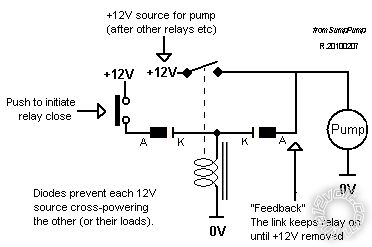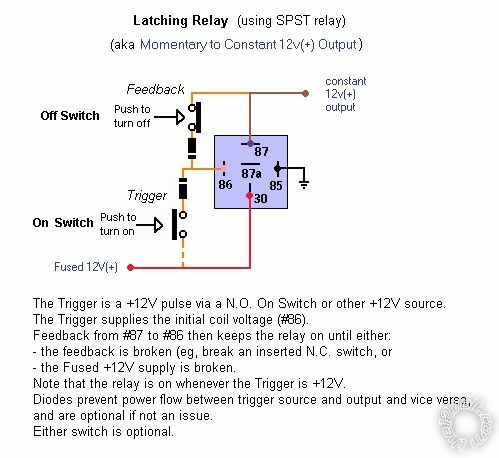stuck on relay for horn
Printed From: the12volt.com
Forum Name: Relays
Forum Discription: Relay Diagrams, SPDT Relays, SPST Relays, DPDT Relays, Latching Relays, etc.
URL: https://www.the12volt.com/installbay/forum_posts.asp?tid=137174
Printed Date: Mayá03, 2024 at 6:00 AM
Topic: stuck on relay for horn
Posted By: nat28
Subject: stuck on relay for horn
Date Posted: Augustá29, 2014 at 3:40 PM
Hi All,
I've spent hours going through the relay forum and haven't found the answer to my problem.
I'm trying to install a second horn in my vehicle that is actuated by a push-button switch. The diagram depicted in the link is what I'm working toward.
However, I'm now testing my wiring on the bench and no joy! When I connect the horn directly to the battery, it works. When I connect the horn directly to battery and switch, it works. However, I can't get the horn/switch to work when wired to the relay. The drawing below is exactly what I have now. The switch (push button) has two posts. I'm assuming one is positive and one is negative, but I'm wondering if one should be connected to 86 in the relay and the other directly to the positive post of the battery?
I'm stuck! Any help is appreciated. Once I figure this out, on to installation.
Thanks.
 ------------- 2013 Subaru Outback Limited
2005 Toyota Sequoia
Replies:
Posted By: nat28
Date Posted: Augustá29, 2014 at 3:42 PM
I should have mentioned that I've two relays. One with 87a as pictured and one with just four posts.
-------------
2013 Subaru Outback Limited
2005 Toyota Sequoia
Posted By: the12volt
Date Posted: Augustá29, 2014 at 4:16 PM
Change terminal 85 from ground to 12V+. -------------  the12volt Ľ Support the12volt.com the12volt Ľ Support the12volt.com
Posted By: howie ll
Date Posted: Augustá30, 2014 at 5:21 AM
Or this way BTW a standard on off switch unless it has built in LED illumination will have neither POS OR NEG polarity, it simply completes the circuit.
AS in your description grounding may be done at any good grounding point:-
horn_switch.png
Note; using ground to switch is the safest method. ------------- Amateurs assume, don't test and have problems; pros test first. I am not a free install service.
Read the installation manual, do a search here or online for your vehicle wiring before posting.
Posted By: nat28
Date Posted: Augustá30, 2014 at 6:42 AM
the12volt wrote:
Change terminal 85 from ground to 12V+.
That works! Thanks. ------------- 2013 Subaru Outback Limited
2005 Toyota Sequoia
Posted By: nat28
Date Posted: Augustá30, 2014 at 6:46 AM
howie ll wrote:
Or this way BTW a standard on off switch unless it has built in LED illumination will have neither POS OR NEG polarity, it simply completes the circuit.
AS in your description grounding may be done at any good grounding point:-
horn_switch.png
Note; using ground to switch is the safest method.
No LED.
Thanks for the diagram. I'm still a little confused as to your recommendation. Are you suggesting, as 12Volt did, to connect 85 to +12V and ground the momentary switch? If this is correct, the relay itself doesn't need to be grounded?
Thanks! ------------- 2013 Subaru Outback Limited
2005 Toyota Sequoia
Posted By: howie ll
Date Posted: Augustá30, 2014 at 6:54 AM
I'm suggesting an alternative to the wise administrator because a ground switching terminal is inherently safer in case of shorts etc. That's why off the top of my head BMW apart, ALL car manufacturers use the circuit I posted.
The relay isn't directly grounded the switch does that to complete the circuit.
The relay is fed a constant live (86 side of the coil).
Using the switch completes the circuit grounding 85 and actuating the relay.
P.S. Your first post, 87a on the other relay isn't used in this circuit.
-------------
Amateurs assume, don't test and have problems; pros test first. I am not a free install service.
Read the installation manual, do a search here or online for your vehicle wiring before posting.
Posted By: oldspark
Date Posted: Augustá30, 2014 at 7:11 AM
Ditto. It also suits single-wire & slip-ring steering wheel grounding switches.
Posted By: nat28
Date Posted: Augustá30, 2014 at 12:05 PM
howie ll wrote:
I'm suggesting an alternative to the wise administrator because a ground switching terminal is inherently safer in case of shorts etc. That's why off the top of my head BMW apart, ALL car manufacturers use the circuit I posted.
The relay isn't directly grounded the switch does that to complete the circuit.
The relay is fed a constant live (86 side of the coil).
Using the switch completes the circuit grounding 85 and actuating the relay.
P.S. Your first post, 87a on the other relay isn't used in this circuit.
I'm looking for the safest way to do this. Does this updated diagram accurately show your suggestions?  ------------- 2013 Subaru Outback Limited
2005 Toyota Sequoia
Posted By: howie ll
Date Posted: Augustá30, 2014 at 12:49 PM
Yes, quite correct.
-------------
Amateurs assume, don't test and have problems; pros test first. I am not a free install service.
Read the installation manual, do a search here or online for your vehicle wiring before posting.
Posted By: nat28
Date Posted: Augustá30, 2014 at 12:57 PM
howie ll wrote:
Yes, quite correct.
Thank you. ------------- 2013 Subaru Outback Limited
2005 Toyota Sequoia
Posted By: the12volt
Date Posted: Augustá30, 2014 at 1:44 PM
Other than supplying 12V+ to 86 instead of 85 and switch to 85 instead of 86, your diagram and howie's suggestion is exactly what I told you to do. The confusion may come from the red line you had drawn in your first diagram from the switch to the relay, which regardless of the color wire used, the switch was still(already) sending ground to one side of the coil of the relay. -------------  the12volt Ľ Support the12volt.com the12volt Ľ Support the12volt.com
Posted By: nat28
Date Posted: Augustá30, 2014 at 3:34 PM
the12volt wrote:
Other than supplying 12V+ to 86 instead of 85 and switch to 85 instead of 86, your diagram and howie's suggestion is exactly what I told you to do. The confusion may come from the red line you had drawn in your first diagram from the switch to the relay, which regardless of the color wire used, the switch was still(already) sending ground to one side of the coil of the relay.
Relays are new to me. Sorry I misunderstood. Thanks. ------------- 2013 Subaru Outback Limited
2005 Toyota Sequoia
Posted By: oldspark
Date Posted: Augustá30, 2014 at 7:58 PM
Nat, keep in mind than an "x" V device needs xV to work.
IE - a 12V relay needs 12V across its coil to operate, hence one end to +12V & the other to 0V (ie, battery -ve terminal, GND etc).
The same is true for bulbs etc. (They are connected in parallel with the supply tho that may not be obvious unless you connect more than one load - ie a few 12V bulbs or relays.)
Posted By: nat28
Date Posted: Augustá30, 2014 at 10:45 PM
oldspark wrote:
Nat, keep in mind than an "x" V device needs xV to work.
IE - a 12V relay needs 12V across its coil to operate, hence one end to +12V & the other to 0V (ie, battery -ve terminal, GND etc).
The same is true for bulbs etc. (They are connected in parallel with the supply tho that may not be obvious unless you connect more than one load - ie a few 12V bulbs or relays.)
Oldspark, pardon my ignorance. Which numbers indicate the ends of the relay? And 0V means ground/-terminal? ------------- 2013 Subaru Outback Limited
2005 Toyota Sequoia
Posted By: oldspark
Date Posted: Augustá30, 2014 at 11:47 PM
See the Relays link above.
But the coil is 85 & 86 with 86 being the most +ve by convention (in case you use a relay with inbuilt diode to quench the coil spark) - as per previous replies.
30, 87 & 87a are the usual "power" = heavy current switching terminals.
30 to 87 are NO = Normally Open and close (make contact, ie, connect) when the coil is energised (12V across it).
NOTE - "Normally" refers to as it/they are when siting on the shelf unused (unless defined otherwise).
30 to 87a are NC = normally closed if 87a exists - ie, SPST (4-pin) relays have 30 & 87 only; SPDT have changeover contacts; 30 goes either to 87 else 87a. Also called 5-pin, but a warning - some 5 pin relays have two 87 contacts.
30 is usually called the power-in terminal but for simple on-off (SPST) using only 30 & 87 it shouldn't matter.
And in some cases 30 is the output with 87 & 87a as inputs (eg, dynamic braking (wiper) motors etc).
Sorry if that's too much info, but that should cover all the basics.
Incidentally, most of us buy SPDT relays and simply don't use 87a if only SPST (4 pin) functionality is needed. Therefore one relay type can replace both - provided the mounting socket allows for it, and provided there isn't substantial cost penalty. (But since most SPST relays are manufactured as SPDT but with the 87a terminal shorn off....)
0V means ground.
Back in the olde days, 12V supplies were often labelled as +12V & -12V, but that really means a 24V supply. Not that it mattered much until OpAmps and amplifier circuits became common and they do use +12V & -12V and a 0V "gnd".
Hence nowadays the battery minus terminal is called 0V or ground or earth or chassis etc. (Except for +ve earth/gnd vehicles where you have 0V & -12V (or -6V for really old vehicles), but they usually called -6V or -12V simply 6V or 12V respectively, else the "hot side".)
Does that help, or confuse?
And there is nothing magic about relays... They are merely remote switches, or (digital) "amplifiers". IE - a small current and switch can connect a big current (elsewhere).
They do have other uses like polarity conversion (change a +12V signal to 0V) and system isolation (a 12V relay switches a 24V or 110VAC load) as well as logic circuits.
Posted By: nat28
Date Posted: Augustá31, 2014 at 6:17 AM
oldspark wrote:
See the Relays link above.
But the coil is 85 & 86 with 86 being the most +ve by convention (in case you use a relay with inbuilt diode to quench the coil spark) - as per previous replies.
30, 87 & 87a are the usual "power" = heavy current switching terminals.
30 to 87 are NO = Normally Open and close (make contact, ie, connect) when the coil is energised (12V across it).
NOTE - "Normally" refers to as it/they are when siting on the shelf unused (unless defined otherwise).
30 to 87a are NC = normally closed if 87a exists - ie, SPST (4-pin) relays have 30 & 87 only; SPDT have changeover contacts; 30 goes either to 87 else 87a. Also called 5-pin, but a warning - some 5 pin relays have two 87 contacts.
30 is usually called the power-in terminal but for simple on-off (SPST) using only 30 & 87 it shouldn't matter.
And in some cases 30 is the output with 87 & 87a as inputs (eg, dynamic braking (wiper) motors etc).
Sorry if that's too much info, but that should cover all the basics.
Incidentally, most of us buy SPDT relays and simply don't use 87a if only SPST (4 pin) functionality is needed. Therefore one relay type can replace both - provided the mounting socket allows for it, and provided there isn't substantial cost penalty. (But since most SPST relays are manufactured as SPDT but with the 87a terminal shorn off....)
0V means ground.
Back in the olde days, 12V supplies were often labelled as +12V & -12V, but that really means a 24V supply. Not that it mattered much until OpAmps and amplifier circuits became common and they do use +12V & -12V and a 0V "gnd".
Hence nowadays the battery minus terminal is called 0V or ground or earth or chassis etc. (Except for +ve earth/gnd vehicles where you have 0V & -12V (or -6V for really old vehicles), but they usually called -6V or -12V simply 6V or 12V respectively, else the "hot side".)
Does that help, or confuse?
And there is nothing magic about relays... They are merely remote switches, or (digital) "amplifiers". IE - a small current and switch can connect a big current (elsewhere).
They do have other uses like polarity conversion (change a +12V signal to 0V) and system isolation (a 12V relay switches a 24V or 110VAC load) as well as logic circuits.
Thanks for the help. For whatever reason, relays do confuse me! I understand that they are an electromagnetic switch, but the variable configurations for wiring them can leave my head spinning! I think part of the problem is that the very simply diagrams that show how the actual relay conducts electricity label the poles 1, 2, 3, 4 rather than 30, 85, 86, 87.
Apparently I do have SPDT relays since mine do have the 87a pole.
In comparing your reply with my revised diagram, I think I'm okay, right?
Thanks again. ------------- 2013 Subaru Outback Limited
2005 Toyota Sequoia
Posted By: howie ll
Date Posted: Augustá31, 2014 at 6:22 AM
Ignore an convention that uses 123 etc.
ISO convention.
85 = coil NEG (-)
86 = coil POS (+)
87 = NO normally open
87a = NC normally closed
30 = common
In other words, at rest 87a (if present is connected to 30.
On energising the coil (think of that as throwing a switch), 87 becomes connected to 30 and 87a is disconnected.
-------------
Amateurs assume, don't test and have problems; pros test first. I am not a free install service.
Read the installation manual, do a search here or online for your vehicle wiring before posting.
Posted By: oldspark
Date Posted: Augustá31, 2014 at 7:54 AM
Fear not Nat, you are not alone.
But for now, forget all those "complex" wirings. As Howard said, you flip a switch which provides (say) 12V to the coil hence magnetising it and pulling the "swinging contact" 30 to 87. Yes, it's an electro-magnetic switch.
And tho Howard says "ignore the 123s" etc, the new micro-DIN relays use 1-5 (eg 1 & 2 are coil; generally 1 = +ve = 86; 2 = -ve = 85) and other relays can use whatever.
I hate the physical digramatic depiction of relays. I prefer the line or circuit diagrams, eg:
(Try to ignore the diodes, and the notes. I'm merely using a pair of my easy to find pics. FYI - they are for pumping water etc out of a bilge or sump, or to keep a tank topped up.)
(And oops - the top diagram does not include the OFF switch shown in the lower diagram.)

... as opposed to ...

Tho the top "circuit" diagram is not that clear, IMO that or similar are easier to follow because you see the contacts, and coil, and how they connect.
I NEVER used relay pin/terminal numbers in diagrams since I did not want to limit to DIN relays (Bosch, Hella etc using pins 30, 87, 86, 85 etc).
In fact I never learned those labels until I started on the12volt. (And even that was after a few years after deciding it was easier memorising them than forever looking them up.)
But because (almost?) all DIN relays have a diagram with pin numbers on them, I found it easy using them in practice despite unlabelled circuit diagram pin numbers.
And if I used my normal JIDEC (Jap) or other relays, I never had to convert pin mumbers on "wiring diagrams" (as per the lower diagram above). Of course I'd have to know the relay's "circuit" relationship to its pin numbers, but they too usually had a schematic or diagram on their body; otherwise I'd have to look at their datasheets etc.
IMO the wiring or "physical" diagrams are good for those that simply want to wire & build. But if you want to understand or fault find, or be able to use different relays, then IMO circuit diagrams are essential.
And now I've probably confused you even more...
But I now use micro-DIN relays instead of the mini-DIN relays (aka cube type as used on the12volt) so translating 30 & 87 etc is a bit of a pain.
Posted By: nat28
Date Posted: Augustá31, 2014 at 8:32 AM
howie ll wrote:
Ignore an convention that uses 123 etc.
ISO convention.
85 = coil NEG (-)
86 = coil POS (+)
87 = NO normally open
87a = NC normally closed
30 = common
In other words, at rest 87a (if present is connected to 30.
On energising the coil (think of that as throwing a switch), 87 becomes connected to 30 and 87a is disconnected.
Thanks. This sentence "On energising the coil (think of that as throwing a switch), 87 becomes connected to 30 and 87a is disconnected." is making sense now. ------------- 2013 Subaru Outback Limited
2005 Toyota Sequoia
Posted By: nat28
Date Posted: Augustá31, 2014 at 8:34 AM
oldspark wrote:
Fear not Nat, you are not alone.
But for now, forget all those "complex" wirings. As Howard said, you flip a switch which provides (say) 12V to the coil hence magnetising it and pulling the "swinging contact" 30 to 87. Yes, it's an electro-magnetic switch.
And tho Howard says "ignore the 123s" etc, the new micro-DIN relays use 1-5 (eg 1 & 2 are coil; generally 1 = +ve = 86; 2 = -ve = 85) and other relays can use whatever.
I hate the physical digramatic depiction of relays. I prefer the line or circuit diagrams, eg:
(Try to ignore the diodes, and the notes. I'm merely using a pair of my easy to find pics. FYI - they are for pumping water etc out of a bilge or sump, or to keep a tank topped up.)
(And oops - the top diagram does not include the OFF switch shown in the lower diagram.)

... as opposed to ...

Tho the top "circuit" diagram is not that clear, IMO that or similar are easier to follow because you see the contacts, and coil, and how they connect.
I NEVER used relay pin/terminal numbers in diagrams since I did not want to limit to DIN relays (Bosch, Hella etc using pins 30, 87, 86, 85 etc).
In fact I never learned those labels until I started on the12volt. (And even that was after a few years after deciding it was easier memorising them than forever looking them up.)
But because (almost?) all DIN relays have a diagram with pin numbers on them, I found it easy using them in practice despite unlabelled circuit diagram pin numbers.
And if I used my normal JIDEC (Jap) or other relays, I never had to convert pin mumbers on "wiring diagrams" (as per the lower diagram above). Of course I'd have to know the relay's "circuit" relationship to its pin numbers, but they too usually had a schematic or diagram on their body; otherwise I'd have to look at their datasheets etc.
IMO the wiring or "physical" diagrams are good for those that simply want to wire & build. But if you want to understand or fault find, or be able to use different relays, then IMO circuit diagrams are essential.
And now I've probably confused you even more...
But I now use micro-DIN relays instead of the mini-DIN relays (aka cube type as used on the12volt) so translating 30 & 87 etc is a bit of a pain.
Having both styles of diagrams helps! Thanks for the explanation. If only there would be one universal labeling standard! ------------- 2013 Subaru Outback Limited
2005 Toyota Sequoia
Posted By: howie ll
Date Posted: Augustá31, 2014 at 8:50 AM
There is ISO/DIN, Google it.
But first read this and the relay section above:- https://www.bcae1.com/relays.htm
-------------
Amateurs assume, don't test and have problems; pros test first. I am not a free install service.
Read the installation manual, do a search here or online for your vehicle wiring before posting.
Posted By: oldspark
Date Posted: Augustá31, 2014 at 10:05 AM
Ah - the beauty of Standards...
... there are so many to chose from!
(Same for RFCs.)
Posted By: howie ll
Date Posted: Augustá31, 2014 at 10:07 AM
The ISO/DIN standard nomenclature is the only WORLD recognised standard for the Automobile industry.
-------------
Amateurs assume, don't test and have problems; pros test first. I am not a free install service.
Read the installation manual, do a search here or online for your vehicle wiring before posting.
|

 the12volt Ľ
the12volt Ľ 

